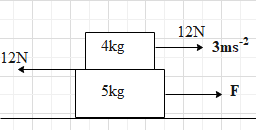Question
Question: A block of mass 4 kg is placed on another block of mass 5 kg and the block B rests on a smooth horiz...
A block of mass 4 kg is placed on another block of mass 5 kg and the block B rests on a smooth horizontal table. If the maximum force that can be applied on A so that both the blocks move together is 12N, find the maximum force that can be applied on B for the blocks to move together.
A. 30N
B. 25N.
C. 27N
D. 48N
Solution
To solve this question first find the acceleration of the blocks when we apply a force on the block A. The highest frictional force between the blocks becomes 12 N. Using these data, balance the forces and find the maximum forces that can be applied on the block A.
Complete answer:
Given in the question that the mass of the box A is mA=4kg
The mass of the block B is mB=5kg
The minimum force that can be applied to block A so that both the blocks move together is 12 N.
Now, when we apply a force on the block A, a frictional force will act between the surface of the block A and block B. frictional force is a force which opposes the motion of a body and the limiting friction is a force which is the maximum frictional force between two surface and at the limiting friction the body will move.
The acceleration of the block A will be,
a=mAF=4kg12N=3ms−2
Now, when we apply force on the block B, then also the frictional force will act between the two bodies. This frictional force will also be maximum at 12 N force.

So, when we subtract the frictional force between the two bodies from the force applied on block B, we will get the mass of block B times the acceleration.
F−12=5×3F−115F=27N
So, the maximum force that can be applied on block B so that both the blocks move together is 27N.
The correct option is (C).
Note:
When one block is on the above of each other, the two blocks will move along with each other when we apply a force only in one block to a certain extent because of the friction force between the blocks. If friction does not exit the block on which force is not applied will move opposite to the motion of the block on which force is applied.
